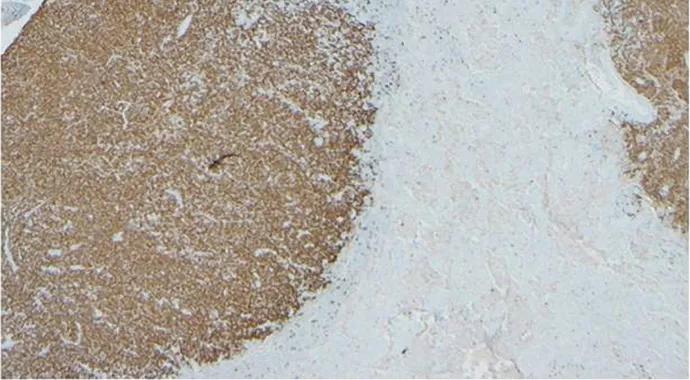Patient has non-Hodgkin lymphoma of synovium

By Nilofar Syed, MD, and Carmen Gota, MD
Advertisement
Cleveland Clinic is a non-profit academic medical center. Advertising on our site helps support our mission. We do not endorse non-Cleveland Clinic products or services. Policy
A 73-year-old woman presented to Cleveland Clinic with persistent left knee pain and swelling. Her history was notable for seropositive erosive rheumatoid arthritis diagnosed in 1980. She initially was treated with nonsteroidal anti-inflammatory drugs and hydroxychloroquine. In the mid-1980s, she was switched to oral methotrexate 12.5 mg weekly. She was maintained on monotherapy with methotrexate, and her disease was felt to be in remission for years. Her family history was notable for malignancies in three siblings ‒ one each with lung, rectal or prostate cancer.
Her knee pain and swelling began approximately four months before her presentation to our rheumatology clinic. She said the pain was worse with activity and improved with rest. She denied having pain or swelling in other joints. She also denied having fevers, chills, morning stiffness or rash. Initial X-ray showed medial compartment narrowing and osteophyte formation. She was treated with an anti-inflammatory medication and physical therapy.
She returned to the clinic four weeks later without improvement of her symptoms. Arthrocentesis yielded minimal fluid; cell count could not be obtained, but cultures were negative. A new erythematous nodule was noted on the anteromedial aspect of the left knee. Biopsy revealed necrotizing granulomatous inflammation consistent with a rheumatoid nodule. She was treated for a relapse of rheumatoid arthritis with a short course of prednisone and two doses of etanercept.
She denied any improvement with prednisone. As she continued to have pain and swelling, she was admitted to the hospital for further evaluation. Laboratory studies revealed elevated ESR (41 mm/hr) and C-reactive protein (6.6 mg/dL). MRI of the left knee showed evidence of synovitis and erosions (Figure 1). Ultrasound-guided arthrocentesis again yielded minimal fluid. Routine cultures were negative, as were fungal and acid fast bacilli smear and cultures. Orthopaedic surgery staff were consulted, and the decision was made to proceed with synovectomy for further evaluation.
Advertisement


FIGURE 1.MRIs of the left knee showing areas of hyperintense synovial proliferation (left) and synovial proliferation with adjacent erosion of the medial femoral condyle (right)
Pathology results revealed an atypical lymphoid infiltrate consistent with diffuse large B cell lymphoma (Figure 2, left image). The cells were positive for CD20 and Epstein-Barr virus (EBV) by chromogenic in situ hybridization (Figure 2, right images). The patient underwent staging with a PET scan and a bone marrow biopsy, neither of which revealed evidence of neoplasm elsewhere. She was started on chemotherapy (rituximab-CHOP regimen) with a plan for post-chemotherapy radiation treatment.

Figure 2. Pathology findings following synovectomy. (Above) Disruption of synovial tissue by an atypical lymphoid infiltrate composed of large cells with vesicular chromatin and multiple prominent nucleoli (H&E, 500× oil). (Top right) Cells positive for CD20 (CD20, 500× oil). (Bottom right) Cells positive for Epstein-Barr virus by chromogenic in situ hybridization (EBER-CISH, 500× oil).
In the setting of well-controlled rheumatoid arthritis, pain in one joint out of proportion to that in other joints is a red flag. This case reflects the importance of considering other causes of chronic monoarthritis.
Primary non-Hodgkin lymphoma originating in the synovium is very rare. Only a few cases have been reported in the literature. The risk of non-Hodgkin lymphoma is increased approximately twofold in patients with rheumatoid arthritis and is especially pronounced in those with higher inflammatory activity. The potential role of disease-modifying antirheumatic drugs and biologics in the development of malignancies is not known, and the link between EBV and the development of lymphoma in rheumatoid arthritis is also unclear.
Advertisement
Moder KG, Tefferi A, Cohen MD, et al. Hematologic malignancies and the use of methotrexate in rheumatoid arthritis: a retrospective study. Am J Med.1995;99(3):276-281.
Kaiser R. Incidence of lymphoma in patients with rheumatoid arthritis: a systematic review of the literature. Clin Lymphoma Myeloma. 2008;8(2):87-93.
The authors thank Soumya Chatterjee, MD, for his editorial input on this article.
Dr. Syed is a former Cleveland Clinic rheumatology fellow who is now an assistant professor in the Department of Rheumatology at UT Southwestern in Dallas.
Dr. Gota is a staff physician in the Department of Rheumatic and Immunologic Diseases. She can be reached at gotac@ccf.org or 216.444.0564.
Advertisement
Advertisement

First-of-its-kind research investigates the viability of standard screening to reduce the burden of late-stage cancer diagnoses

Global R&D efforts expanding first-line and relapse therapy options for patients

Study demonstrates ability to reduce patients’ reliance on phlebotomies to stabilize hematocrit levels

A case study on the value of access to novel therapies through clinical trials

Findings highlight an association between obesity and an increased incidence of moderate-severe disease

Cleveland Clinic Cancer Institute takes multi-faceted approach to increasing clinical trial access 23456

Key learnings from DESTINY trials

Overall survival in patients treated since 2008 is nearly 20% higher than in earlier patients